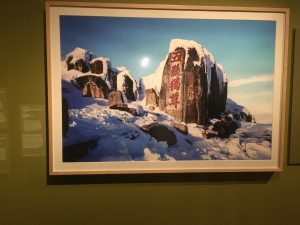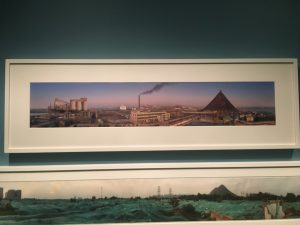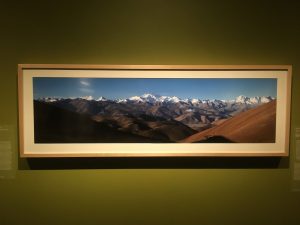The Patriarch of the Five Sacred Mountains on Mount Tai, 2001 By: Yan Shi
This is a photo of a series of rocks atop a snowy mountain top. The left side of the rocks are in light and feature chinese characters inscribed in them in a red color. The right side of the photo is in shadow which helps highlight the bright glowing red calligraphy that is carved into the left face of the rocks. The photo itself is very clear and crisp which really captures the overall cold vibe of the photo. The photographer seems to be trying to capture the beauty of the characters in a natural landscape. The description of the photo states that the inscription on the rocks are an emblem for Mount Tai. It is almost as if these inscriptions are sort of the entrance/peak of this mountain top. The rock sort of serves as the historical landmark that has had generations leave their mark on it.

After the Painting “Autumn Colors in the Que and Hua Mountains” By: Hong Lei
I really like this photo and I think that’s because I enjoy photographs of industrial structures. Metal structures are somewhat menacing and majestic in their own way. The photo is a panoramic view of an industrial factory complex. And it is pieced together from multiple photos to create the panoramic effect. The sky has a purple and blue gradient that creates sort of a calm feeling to the photo which consists of a maze of metal, concrete and smoke stacks. There is one particular smoke stack in the center of the image that has smoke coming out dividing the image entirely in half. It disturbs the light purple sky and interrupts the flow of the photo. That being said the smoke sort of represents how industry/industrialism interrupts the beauty of nature. Which is what I think the photographer is trying to emphasize through this photo. Nature is sacred and industrialism puts in danger the environment that people need to inhabit.

The Four Deities of the Himalayan Range, By: Zhang Anlu
This is an incredibly breathtaking image. The photograph features a series of mountain scapes that go from a dark sandy brown all the way to snowy mountain tops. The photographer seems to capture miles and miles of mountain tops all from the peak that they are perched on. The 4 Himalayan peaks are often not seen and I assume that is because of cloud coverage. However, Photographer Zhang Anlu manages to capture an exciting photo of a crisp cool mountain scapes that changes dramatically in light and dark shades. The mountains create a sort of gradient of light and dark all the way until it hits the horizon line and blue sky. The photographer creates and almost unreal image. They bring you to an almost otherworldly environment through this image.





The color of the light in the first photo you discuss by Yan Shi is lovely and has the warmth of either early in the day or late in the afternoon what we call the golden hour.
The panorama by Hong Lei looks incredibly realistic compared with
Thomas Schiff’s 360 degree photos of libraries
I don’t think there is any nature in this photo. I think the photographer uses the panorama to evoke a scroll and the pile is supposed to evoke a traditional mountain form. I think the viewer is supposed to horrified by this landscape. Unlike say early 20th century American photographers like Charles Steeler who celebrated industrial forms.
I wonder if the last photo you discuss by Zhang Anlu is also a composite panorama? It is not quite as horizontal as your second photo but its aspect ration is very horizontal. I don’t know any cameras that shoot an image in this shape.